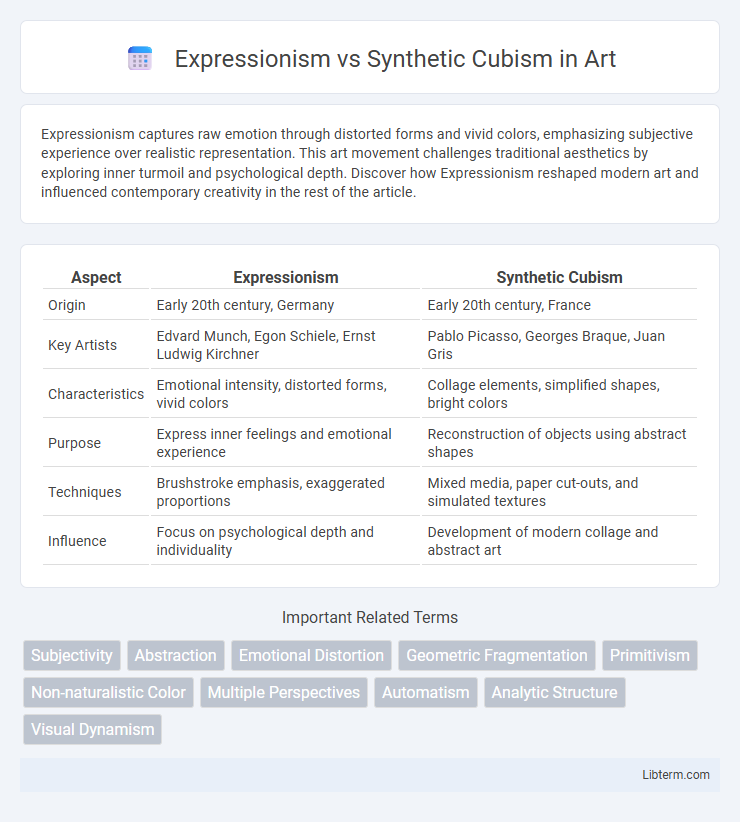Expressionism captures raw emotion through distorted forms and vivid colors, emphasizing subjective experience over realistic representation. This art movement challenges traditional aesthetics by exploring inner turmoil and psychological depth. Discover how Expressionism reshaped modern art and influenced contemporary creativity in the rest of the article.
Table of Comparison
| Aspect | Expressionism | Synthetic Cubism |
|---|---|---|
| Origin | Early 20th century, Germany | Early 20th century, France |
| Key Artists | Edvard Munch, Egon Schiele, Ernst Ludwig Kirchner | Pablo Picasso, Georges Braque, Juan Gris |
| Characteristics | Emotional intensity, distorted forms, vivid colors | Collage elements, simplified shapes, bright colors |
| Purpose | Express inner feelings and emotional experience | Reconstruction of objects using abstract shapes |
| Techniques | Brushstroke emphasis, exaggerated proportions | Mixed media, paper cut-outs, and simulated textures |
| Influence | Focus on psychological depth and individuality | Development of modern collage and abstract art |
Introduction to Expressionism and Synthetic Cubism
Expressionism emerged in the early 20th century as an art movement emphasizing emotional experience over physical reality, characterized by bold colors and distorted forms to evoke subjective feelings. Synthetic Cubism, developed by Pablo Picasso and Georges Braque around 1912-1914, introduced simpler shapes, brighter colors, and collage elements to construct images from fragmented parts. Both movements transformed traditional representation, yet Expressionism focused on emotional intensity while Synthetic Cubism emphasized structural composition and conceptual abstraction.
Historical Context and Origins
Expressionism emerged in early 20th-century Germany as a response to rapid industrialization and social upheaval, emphasizing emotional intensity and subjective experience. Synthetic Cubism developed in France around 1912, characterized by the collage technique and simpler shapes, reflecting a shift from analytical fragmentation to reconstruction. Both movements reacted to modernity but diverged in techniques and conceptual focus, with Expressionism prioritizing inner emotions and Synthetic Cubism exploring form and materiality.
Key Philosophies and Artistic Intent
Expressionism emphasizes emotional experience and inner feelings, using distorted forms and vivid colors to evoke subjective reality. Synthetic Cubism focuses on deconstructing objects into geometric shapes and reconstructing them in abstracted, collage-like compositions to explore multiple perspectives simultaneously. Expressionism prioritizes personal expression and emotional depth, whereas Synthetic Cubism aims to analyze and represent the structure of forms through intellectual abstraction.
Major Artists and Influential Figures
Expressionism, exemplified by artists like Edvard Munch and Egon Schiele, emphasized emotional experience through bold colors and distorted forms, reflecting intense psychological content. Synthetic Cubism, pioneered by Pablo Picasso and Georges Braque, introduced collage elements and simpler shapes to represent multiple perspectives simultaneously, highlighting a shift toward abstraction. Both movements significantly transformed modern art by redefining visual representation and emotional expression.
Visual Style and Techniques Compared
Expressionism emphasizes intense emotional impact through distorted forms, bold colors, and vigorous brushstrokes that convey subjective experience. Synthetic Cubism introduces simplified shapes, fragmented objects, and collage elements, using muted palettes and flattened perspectives to reconstruct reality. While Expressionism exploits emotional distortion, Synthetic Cubism focuses on analytical spatial reassembly and integration of diverse materials.
Use of Color and Composition
Expressionism employs bold, vivid colors with high emotional intensity, often using distorted forms and dynamic brushstrokes to evoke subjective feelings. Synthetic Cubism features a more restrained, muted color palette combined with fragmented, geometric shapes and collage elements, emphasizing structural composition and multiple viewpoints. The contrast lies in Expressionism's focus on emotional depth through color, whereas Synthetic Cubism prioritizes spatial relationships and compositional innovation.
Representation of Subject Matter
Expressionism emphasizes emotional experience through distorted forms and vivid colors, often portraying intense psychological states and subjective interpretations of reality. Synthetic Cubism, pioneered by Picasso and Braque, breaks down objects into geometric shapes and reassembles them from multiple perspectives, combining real elements like collage with abstracted forms to depict subjects in a fragmented, yet cohesive manner. Representation in Expressionism centers on inner feelings, while Synthetic Cubism prioritizes analytical reconstruction of visual reality.
Cultural and Social Impact
Expressionism's cultural impact centers on its raw emotional intensity and social critique, reflecting post-World War I anxieties and alienation through distorted forms and bold colors. Synthetic Cubism influenced cultural perceptions by deconstructing reality into geometric shapes, challenging traditional perspectives and promoting modernist ideas about fragmentation and reconstruction in art. Both movements shaped the 20th-century art narrative by addressing societal changes--Expressionism through emotional depth and social turmoil, Synthetic Cubism through intellectual exploration and visual innovation.
Lasting Legacy in Modern Art
Expressionism's lasting legacy in modern art is evident through its intense emotional impact and bold use of color, influencing movements like Abstract Expressionism and Neo-Expressionism. Synthetic Cubism pioneered the integration of mixed media and collage, reshaping the boundaries of visual representation and inspiring contemporary multimedia art. Both movements fundamentally transformed artistic approaches by challenging traditional perspectives and emphasizing subjective experience and abstraction.
Conclusion: Expressionism and Synthetic Cubism in Perspective
Expressionism and Synthetic Cubism represent distinct artistic movements that emphasize emotional intensity and fragmented forms, respectively, shaping modern art's evolution. Expressionism prioritizes subjective experience and emotional depth through bold colors and distorted figures, while Synthetic Cubism reconstructs reality using abstract shapes and collage techniques to explore multiple perspectives. Both movements challenge traditional representation, influencing contemporary art by expanding the boundaries of visual expression and conceptual interpretation.
Expressionism Infographic

 libterm.com
libterm.com